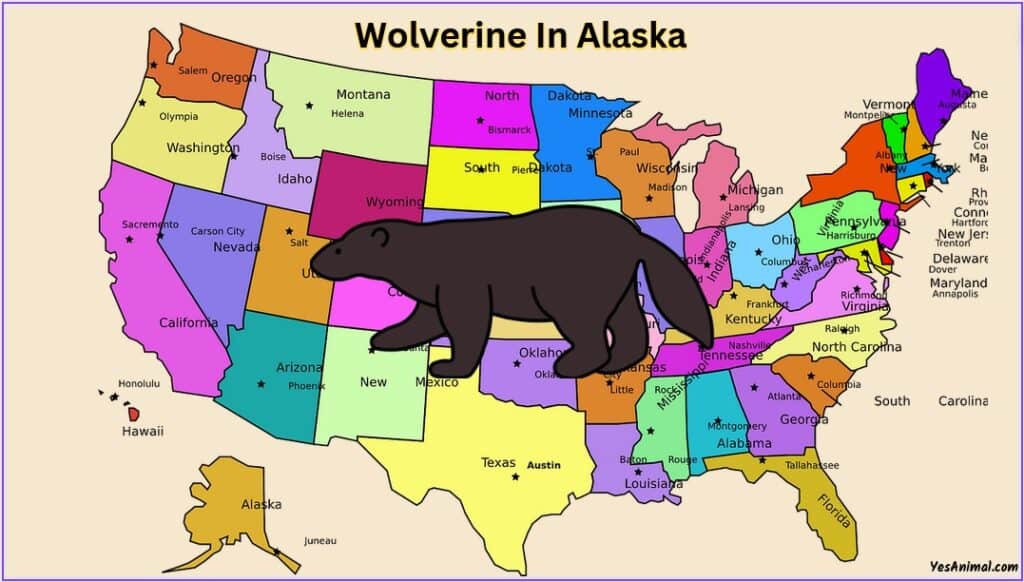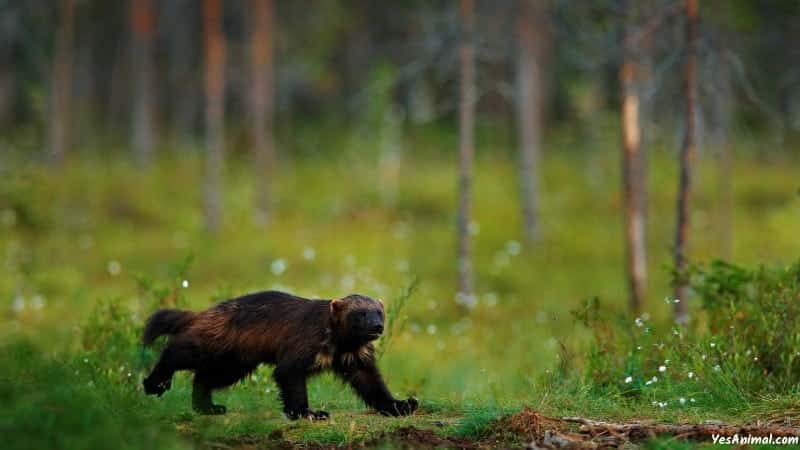Last Updated on September 14, 2023 by Amin Tawar
Are There Wolverine In Alaska?

Wolverines are found all over Alaska but there are regions that wolverines avoid at lower densities as the habitat is not appropriate for denning or areas developed by people.
They are wide-ranging animals that can be found in the taiga and boreal areas of the state. In Alaska, they are mostly seen residing throughout mainland Alaska and on a few islands in the Southeast region of Alaska.
How many Wolverines are in Alaska?
The exact population of wolverines in the state is not available but, they are mostly found in low densities in Alaska. Research from Chugach National Forest has stated that a wolverine density of 5.0 wolverines per 1,000 square kilometers in Turnagain Arm and Kenai Mountains regions, which is also usual for other spots of South-central regions of Alaska.
Home range estimations of wolverines in Alaska show female wolverines around 300 to 600 square kilometers and male wolverines around 700 to 1,000 square kilometers.
What is the Alaskan name for Wolverine?
In Alaska, the wolverine is called the Gulo gulo, indicating “glutton.” it got its name, from the action of it eating carrion or live prey. As the wolverine’s eating style seems voracious, directing to the nickname of “glutton” and also the origin of the scientific name of the animal.
What does Wolverine eat in Alaska?

Wolverines are opportunistic hunters and they consume anything they kill or find. They are reasonably adapted for scavenging. Their powerful jaw and huge neck muscles let them crush into frozen flesh and big bones. Also, they can survive on very little food for prolonged periods. Their diet usually reflects seasonal changes in food availability in the state.
During winter wolverines mostly feed on carrion, remains of caribou and moose shot by hunters and killed by wolves, or animals that have passed away due to biological reasons.
Throughout the year, they feed on medium and small-sized animals like squirrels, voles, birds, and snowshoe hares. In suitable conditions, wolverines can also kill moose, caribou, or dall sheep, but these happenings are very rare. They are also known to take down young Dall sheep during spring when they are most weak.
Also Check Our Guide On Wolverine in United States
Can you hunt Wolverine in Alaska?
Hunting wolverines in Alaska is illegal. However, there are different approaches to harvesting or observing wolverines in Alaska. The Department of Fish and Game in Alaska has a Wolverine Management Program that is used to collect biological information about Wolverine in Alaska.
Also, trappers can obtain a special ticket from the Alaska Department of Fish and Game to observe or harvest a wolverine in the state. This means they can skin the wolverine and keep it for their personal use. However, this permit does not allow the trapper the power to hunt the wolverine, instead, just takes the species for its fur.
Can foreigners hunt Wolverine in Alaska?
A non-resident who is out hunting in the Alask Wild must be personally escorted by an Alaska-licensed hunting guide or by an Alaska resident who is 19 years of age or older. This is compulsory for any kind of big game animal that is being hunted in the state.
Can you eat Wolverine in Alaska?
Humans can eat wolverine meat but you cannot eat wolverine meat in Alaska as it is illegal to hunt them for meat in Alaska. Besides, the local people of Alaska also do not believe wolverine is an edible animal in the state. Also, it is not advisable to consume wolverine meat, as uncooked meat can be harmful to humans when consumed.
How many wolverines are left in the US?
Only roughly, 300 wolverines live in the US, but scientists predict that there were not many below Alaska and Canada as their naturally low wolverines population density and demand for alpine habitat.
Wolverine’s habitat in the US range over mountainous terrains in the North Cascades and the Rocky Mountains. They have been reclaiming their territory in Wyoming, Montana, Washington, and Idaho.
Conclusion
And that was everything you need to know about the Wolverine in Alaska. I hope this article answered all your queries.
Thank You For Reading!
Our Source For This Guide